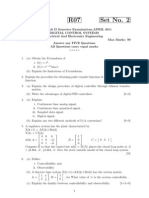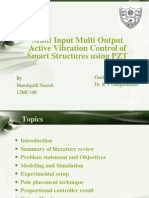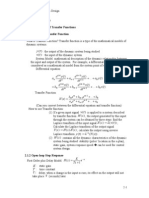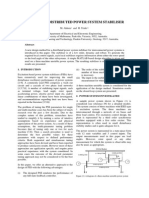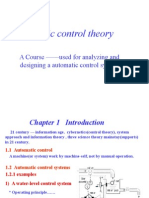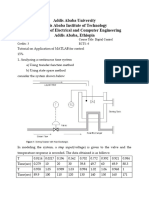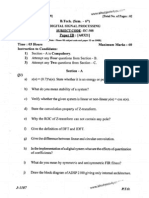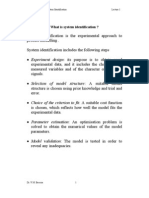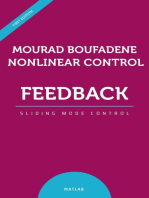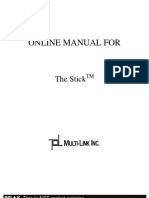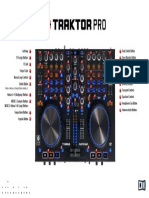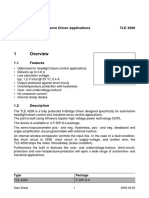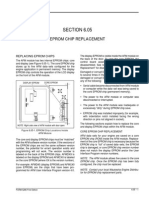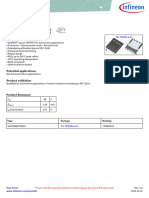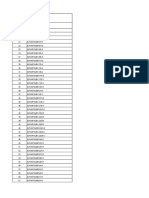0 ratings0% found this document useful (0 votes)
41 viewsPEE-504 IDdcsE0484
PEE-504 IDdcsE0484
Uploaded by
Melissa CannonThis document contains an 8 question exam on digital control systems. It covers topics such as:
1) The basic elements of a digital control system including sampling and hold operations. Sampling converts a continuous signal to discrete samples.
2) Comparison of different hold circuit types based on impulse and frequency response. Hold circuits are needed to reconstruct the continuous output signal from discrete samples.
3) Analysis of digital control systems using z-transforms and comparison to analog systems. Z-transforms are useful for digital system analysis while s-domain methods are not directly applicable.
4) Stability analysis methods for digital control systems including why the root locus method is not directly applicable. Stability is a key consideration.
Copyright:
© All Rights Reserved
Available Formats
Download as PDF, TXT or read online from Scribd
PEE-504 IDdcsE0484
PEE-504 IDdcsE0484
Uploaded by
Melissa Cannon0 ratings0% found this document useful (0 votes)
41 views2 pagesThis document contains an 8 question exam on digital control systems. It covers topics such as:
1) The basic elements of a digital control system including sampling and hold operations. Sampling converts a continuous signal to discrete samples.
2) Comparison of different hold circuit types based on impulse and frequency response. Hold circuits are needed to reconstruct the continuous output signal from discrete samples.
3) Analysis of digital control systems using z-transforms and comparison to analog systems. Z-transforms are useful for digital system analysis while s-domain methods are not directly applicable.
4) Stability analysis methods for digital control systems including why the root locus method is not directly applicable. Stability is a key consideration.
Copyright
© © All Rights Reserved
Available Formats
PDF, TXT or read online from Scribd
Share this document
Did you find this document useful?
Is this content inappropriate?
This document contains an 8 question exam on digital control systems. It covers topics such as:
1) The basic elements of a digital control system including sampling and hold operations. Sampling converts a continuous signal to discrete samples.
2) Comparison of different hold circuit types based on impulse and frequency response. Hold circuits are needed to reconstruct the continuous output signal from discrete samples.
3) Analysis of digital control systems using z-transforms and comparison to analog systems. Z-transforms are useful for digital system analysis while s-domain methods are not directly applicable.
4) Stability analysis methods for digital control systems including why the root locus method is not directly applicable. Stability is a key consideration.
Copyright:
© All Rights Reserved
Available Formats
Download as PDF, TXT or read online from Scribd
Download as pdf or txt
0 ratings0% found this document useful (0 votes)
41 views2 pagesPEE-504 IDdcsE0484
PEE-504 IDdcsE0484
Uploaded by
Melissa CannonThis document contains an 8 question exam on digital control systems. It covers topics such as:
1) The basic elements of a digital control system including sampling and hold operations. Sampling converts a continuous signal to discrete samples.
2) Comparison of different hold circuit types based on impulse and frequency response. Hold circuits are needed to reconstruct the continuous output signal from discrete samples.
3) Analysis of digital control systems using z-transforms and comparison to analog systems. Z-transforms are useful for digital system analysis while s-domain methods are not directly applicable.
4) Stability analysis methods for digital control systems including why the root locus method is not directly applicable. Stability is a key consideration.
Copyright:
© All Rights Reserved
Available Formats
Download as PDF, TXT or read online from Scribd
Download as pdf or txt
You are on page 1of 2
Roll No. ......................
Total No. of Questions: 08) [Total No. of Pages : 02
(
~.// q0
~/~ ~~
1~
0\'"
M. Tech.
DIGITAL CONTROL SYSTEMS
~:PEE-504
Paper ID : [E0484]
(Note: Please till subject code and paper, ID on OMR)
Time: 03 Hours
Instruction to Candidates:
1) Attempt any Five questions.
2) All questions carry equal marks.
3) Missing data, if any can be suitably assumed.
Maximum Marks: 100
Ql) (a) What are Digital control systems and how are these different from
Analog control systems? With an aid of a block diagram show basic
, elements of a digital control system and give functioning of these elements.
(b) What is meant by samplin&and hold operations? What are types of
sampling operations? In case of an Ideal sampling show that L.T of
sampled output, f*(t) is given by
00
F*(s)= "Lf(nT)e-nsT
n=O
where T is sampling period.
Q2) (a) What are hold-operation? Why is hold operation needed in a digital control
systems? Derive expression ofT.F. 01a simple type of hold-circuit.
(b) Based on "impulse response" and 'frequency response" give a
comparison of various hold-circuits.
Q3) (a) Whyis z-transformuseful in analysis of digital control systems?Define
Pulse T.F.Also mention limitations of z-transform.
(b) Enumerate steps involved in obtaining z-transform of a function, f(t).
Obtain z-transform of the following:
J;(t) =e-fJlsin {3 t
J;(t) = cos rot.
Q4) (a) Define stability of digital control systems. Enumerate various methods
used for stability investigation of such systems. Why is R-H criterion
not directly applicable in stability analysis of such systems - explain.
J-4196{8129}
R T.O.
(b) Solve the following difference equation using z-transform:
y(k + 2) - 0.1y(k+ 1)- 0.2y(k) = u (k + 1)+ u(k)with- y (0) = 0& ,
y(l) = O,.k= 0;1,2, ,.....
Q5) (a) Discuss working of a Digital position ,control systemwith a simplified
block diagram. .
(b) Discuss the stepping motor-operation with control action included and
disk drive systemincorporated. .
Q6) (a) What is need of compensator in a digital control system? Discuss the
procedure of design of digital controllers.
(b) The pulsed TF of a digital control system without compensation is
(, -1
)
[
880
] given by GhoGp(z) = ,1- z Z S2(S +8.8)
use Bilinear transformation & design a lead controller to meet the
followingrequirements:
Phase margin = 450&
resonance peak Mp:: 6.7.
Q7) (a) Show state variable representation of an analog control system described
by an input-output re~ation in form of a differential equation. Also derive
TF of the system from the state variable model so obtained.
(b) An analog system is described by following SE and OE of the form
[
Xl =X2
X2 =-2XI-3x2 +u
SE
Y=Xj: OE
Obtain TF and find eigen values of the system.
Q8) (a) Develop state variable description of a digital control system with
u(k) = input signal at kth instant
y(k) = output-signal at kth instant
&x (k) = state variable at kth instant
Also obtain TF of above system.
(b) Give state variable model of a digital contr~l system if input-output
relation of the system dynamics is described by differential ego
y (k + 3) + 5y (k + 2) + 3Y (k + 1) + 2y (k) = u(k).
0*0*
J-4196
2
You might also like
- Asus FA506II DA0BKXMB8D0 REV D SchematicDocument49 pagesAsus FA506II DA0BKXMB8D0 REV D SchematicNV Hào33% (3)
- Problem 2Document4 pagesProblem 2Jade Do0% (1)
- Digital Control System Paper PDFDocument2 pagesDigital Control System Paper PDFdeepaksaini14No ratings yet
- Ele-504 Id-E0484Document2 pagesEle-504 Id-E0484suma sriNo ratings yet
- R07 Set No. 2Document8 pagesR07 Set No. 2chenumallaNo ratings yet
- 510Document8 pages510chenumallaNo ratings yet
- Tutorial 6 PDFDocument2 pagesTutorial 6 PDFCrack110011No ratings yet
- 4364 540 DigitalControlDocument2 pages4364 540 DigitalControlyogesh_b_kNo ratings yet
- Experiment No.1: Introduction To Lti Representation and Transfer Function ModelDocument7 pagesExperiment No.1: Introduction To Lti Representation and Transfer Function ModelIra CervoNo ratings yet
- skemaSEE4113sem20809correction 1Document25 pagesskemaSEE4113sem20809correction 1239191No ratings yet
- TUTORIAL 6 - System ResponseDocument15 pagesTUTORIAL 6 - System ResponsetiraNo ratings yet
- EC 2255 Control SystemsDocument5 pagesEC 2255 Control SystemsselvijeganNo ratings yet
- rr420201 Digital Control SystemsDocument8 pagesrr420201 Digital Control SystemsSRINIVASA RAO GANTANo ratings yet
- Review PPT Modified KLJLKDocument30 pagesReview PPT Modified KLJLKPranith KumarNo ratings yet
- Identification: 2.1 Identification of Transfer Functions 2.1.1 Review of Transfer FunctionDocument29 pagesIdentification: 2.1 Identification of Transfer Functions 2.1.1 Review of Transfer FunctionSucheful LyNo ratings yet
- Question Paper Code: 55336: B.E./B.Tech. DEGREE EXAMINATIONS, NOV./DEC. 2011 Regulations 2008Document4 pagesQuestion Paper Code: 55336: B.E./B.Tech. DEGREE EXAMINATIONS, NOV./DEC. 2011 Regulations 2008Sarika VadivelanNo ratings yet
- Control SystemsDocument8 pagesControl Systemsvasantha_btechNo ratings yet
- 4364 523 CsiiDocument4 pages4364 523 Csiiyogesh_b_kNo ratings yet
- Question Paper Code: 11287Document5 pagesQuestion Paper Code: 11287Nishanth NiraiNo ratings yet
- Assignment 1 MCTE 3313 Sem 1 2018 2019Document3 pagesAssignment 1 MCTE 3313 Sem 1 2018 2019Nurmi Elisya RosliNo ratings yet
- ,I-328 (tr037 A) I',6l: B.Tech (Semester - 4th)Document3 pages,I-328 (tr037 A) I',6l: B.Tech (Semester - 4th)MohitNo ratings yet
- Design of A Distributed Power System Stabiliser: Infinite BusbarDocument6 pagesDesign of A Distributed Power System Stabiliser: Infinite BusbarRudanekNo ratings yet
- DcsDocument8 pagesDcsgeoprayNo ratings yet
- Lab 3Document14 pagesLab 3Maitha SaeedNo ratings yet
- rr321303 Advanced Control SystemsDocument8 pagesrr321303 Advanced Control SystemsSRINIVASA RAO GANTANo ratings yet
- EE QuesDocument7 pagesEE Quespratikchattopadhyay2No ratings yet
- Process Dynamics and Control PREV PAPERDocument9 pagesProcess Dynamics and Control PREV PAPERNisha TNNo ratings yet
- 22531-Control System and PLC (CSP) 030819Document3 pages22531-Control System and PLC (CSP) 030819omandlik30No ratings yet
- Papers Even2010 11 Eee8sem2011Document12 pagesPapers Even2010 11 Eee8sem2011Himanshu VohraNo ratings yet
- Automatic Control Theory: A Course - Used For Analyzing and Designing A Automatic Control SystemDocument53 pagesAutomatic Control Theory: A Course - Used For Analyzing and Designing A Automatic Control SystemOmar DawaghrehNo ratings yet
- Assignment One Regular AAIT 2022Document6 pagesAssignment One Regular AAIT 2022tsegaye2321No ratings yet
- Code No: 35051Document8 pagesCode No: 35051SRINIVASA RAO GANTANo ratings yet
- CS Previous Question PapersDocument48 pagesCS Previous Question PapersShaleva SinghNo ratings yet
- 45 37295 Ee311 2013 1 1 1 Ee311Document11 pages45 37295 Ee311 2013 1 1 1 Ee311Osama AhmedNo ratings yet
- Automatic Control Theory: A Course - Used For Analyzing and Designing A Automatic Control SystemDocument53 pagesAutomatic Control Theory: A Course - Used For Analyzing and Designing A Automatic Control SystemMeet VekariaNo ratings yet
- Project Fall2015Document5 pagesProject Fall2015AlvinNo ratings yet
- Eee 550 - Advanced Control Systems November 2008Document7 pagesEee 550 - Advanced Control Systems November 2008Kumaraguru RauNo ratings yet
- Linear Control Engineering QBDocument11 pagesLinear Control Engineering QBAkizuki TakaoNo ratings yet
- LDCS QuestionsDocument10 pagesLDCS QuestionsRiya SinghNo ratings yet
- Digital Control Systems May 2007 Question PaperDocument8 pagesDigital Control Systems May 2007 Question Paperelimelek100% (3)
- Control - Systems (2013) Previous Paper PDFDocument1 pageControl - Systems (2013) Previous Paper PDFnarendran069No ratings yet
- Ec 308Document2 pagesEc 308satbir2008No ratings yet
- Control Systems Jan 2014Document2 pagesControl Systems Jan 2014Prasad C MNo ratings yet
- Jntuworld: R05 Set No. 2Document8 pagesJntuworld: R05 Set No. 2vanamgouthamNo ratings yet
- What Is System Identification ?Document8 pagesWhat Is System Identification ?Satria NugrahaNo ratings yet
- Lab 4: Linear Time-Invariant Systems and Representation: ObjectivesDocument6 pagesLab 4: Linear Time-Invariant Systems and Representation: ObjectivesFahad AneebNo ratings yet
- B. Tech Control SystemsDocument2 pagesB. Tech Control SystemsAnant VermaNo ratings yet
- ĐỀ CƯƠNG ÔN TẬP PHẦN LÝ THUYẾT LTĐKTĐ - 2023-2024 - EN - Final - UploadDocument13 pagesĐỀ CƯƠNG ÔN TẬP PHẦN LÝ THUYẾT LTĐKTĐ - 2023-2024 - EN - Final - UploadThịnh Nguyễn QuốcNo ratings yet
- Final Exam - SampleDocument4 pagesFinal Exam - SampleAhmed MashhoorNo ratings yet
- Signals Systems Lab 2Document5 pagesSignals Systems Lab 2ahmad.a.touseefNo ratings yet
- CTRJun2010 (حديث)Document3 pagesCTRJun2010 (حديث)Eng M. EissaNo ratings yet
- Signals and SystemsDocument2 pagesSignals and SystemsJanani MunisamyNo ratings yet
- ESE Online Test Series: 2015 Conventional Paper: E & T: Electronics & Telecommunication EnggDocument3 pagesESE Online Test Series: 2015 Conventional Paper: E & T: Electronics & Telecommunication EnggPraveen Kumar ArjalaNo ratings yet
- Signals and Systems Model - 1Document2 pagesSignals and Systems Model - 1sharanyameen2704No ratings yet
- MATLAB and Its Control ToolboxDocument41 pagesMATLAB and Its Control ToolboxzkqasimNo ratings yet
- Note - 13 - Intro To Digital Control SystemDocument7 pagesNote - 13 - Intro To Digital Control SystemVimal Raj DNo ratings yet
- Discret IzationDocument18 pagesDiscret IzationsydofneeNo ratings yet
- Nonlinear Control Feedback Linearization Sliding Mode ControlFrom EverandNonlinear Control Feedback Linearization Sliding Mode ControlNo ratings yet
- Student Solutions Manual to Accompany Economic Dynamics in Discrete Time, second editionFrom EverandStudent Solutions Manual to Accompany Economic Dynamics in Discrete Time, second editionRating: 4.5 out of 5 stars4.5/5 (2)
- An 75004Document3 pagesAn 75004ClenaNo ratings yet
- Panel Dual Polarization Half-Power Beam Width Fixed Electrical DowntiltDocument2 pagesPanel Dual Polarization Half-Power Beam Width Fixed Electrical DowntiltFerhat SayinNo ratings yet
- For Stationary and Shipborne Applications: External Power SupplyDocument4 pagesFor Stationary and Shipborne Applications: External Power SupplyMukti SuhendroNo ratings yet
- Online Manual For: The StickDocument38 pagesOnline Manual For: The StickPayphone.comNo ratings yet
- VLSI Design and VerificationDocument37 pagesVLSI Design and Verificationvsrkrishna8303No ratings yet
- E22-400M22S Usermanual EN v1.4-3Document13 pagesE22-400M22S Usermanual EN v1.4-3bahaNo ratings yet
- Varistor Specification PDFDocument15 pagesVaristor Specification PDFAisha IsaNo ratings yet
- Utc8n65 PDFDocument8 pagesUtc8n65 PDFGerson FelipeNo ratings yet
- Camara AVERMEDIA SF1301Document68 pagesCamara AVERMEDIA SF1301TecnoSmartNo ratings yet
- Akiyama - Tempus PRO PDFDocument1 pageAkiyama - Tempus PRO PDFD CNo ratings yet
- USB To 4 Ports RS485/422 Converter User ManualDocument9 pagesUSB To 4 Ports RS485/422 Converter User ManualDamijan SrdočNo ratings yet
- Amf25nt PDFDocument88 pagesAmf25nt PDFBùi Tấn Dũng100% (1)
- DC Motor Driver For Servo Driver Applications TLE 4209: Type PackageDocument13 pagesDC Motor Driver For Servo Driver Applications TLE 4209: Type PackageArmannovNo ratings yet
- 323-1851-545.r1.2 - OME6500 Module Replacement ProcedureDocument114 pages323-1851-545.r1.2 - OME6500 Module Replacement ProcedureJonatn Silva100% (1)
- UNIT 2 PV Energy SystemsDocument44 pagesUNIT 2 PV Energy SystemsVIJAYKUMAR GNo ratings yet
- VLSI SyllabusDocument57 pagesVLSI SyllabusAkshay DeshpandeNo ratings yet
- K430WQC V3 FFDocument14 pagesK430WQC V3 FFFeroz KhanNo ratings yet
- EPROM Chip ReplacementDocument5 pagesEPROM Chip ReplacementMuhammadShadabNo ratings yet
- Short Message Service SMS: UsesDocument4 pagesShort Message Service SMS: UsesAditya R. AchitoNo ratings yet
- Axpert mks4000Document20 pagesAxpert mks4000Khalid MohammadNo ratings yet
- Principles of EE1 - Chapter 1 - Introduction & Circuit VariablesDocument50 pagesPrinciples of EE1 - Chapter 1 - Introduction & Circuit VariablesDu ĐặngNo ratings yet
- Zigbee Interfacing With ArduinoDocument10 pagesZigbee Interfacing With ArduinoSystech AsesoresNo ratings yet
- 01-Introduction To OMNIDocument19 pages01-Introduction To OMNIvibinkumars100% (1)
- Sun Fire V240-Arch - WPDocument32 pagesSun Fire V240-Arch - WPMow_EngrNo ratings yet
- RS 485 USB Installation and User ManualDocument5 pagesRS 485 USB Installation and User ManualJohn SafeerNo ratings yet
- Utran Kpi - Mapping - NSN Huawei - EricssonDocument129 pagesUtran Kpi - Mapping - NSN Huawei - Ericssonlekha20No ratings yet
- Infineon IAUCN08S7N013 DataSheet v01 00 EN-3392519Document13 pagesInfineon IAUCN08S7N013 DataSheet v01 00 EN-3392519Achintya AsthanaNo ratings yet
- Distributed Reconfigurable Intelligent Surfaces For Energy-Efficient Indoor Terahertz Wireless CommunicationsDocument15 pagesDistributed Reconfigurable Intelligent Surfaces For Energy-Efficient Indoor Terahertz Wireless CommunicationsPoornimaNo ratings yet
- Hart Am OdalDocument6 pagesHart Am OdalShery MujosNo ratings yet





